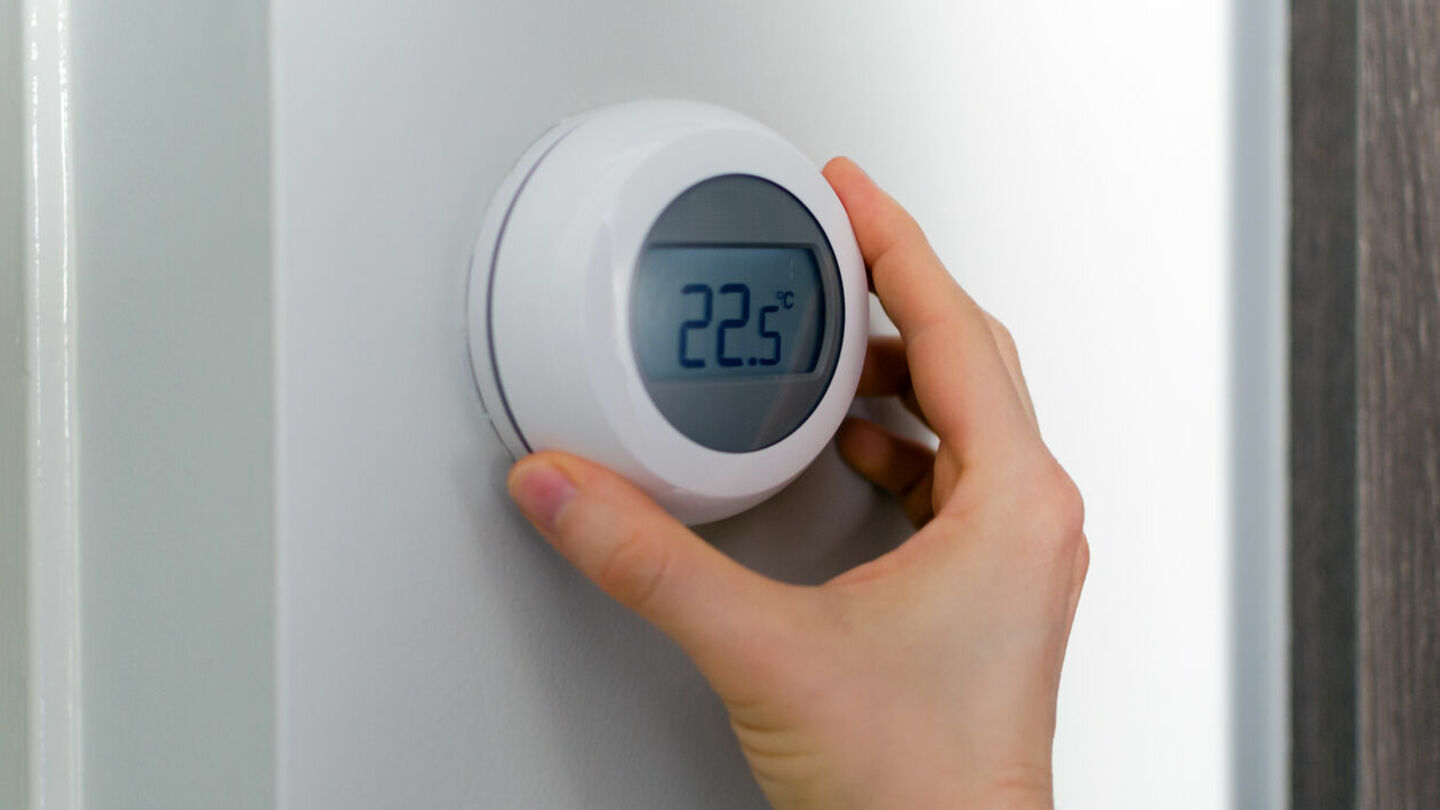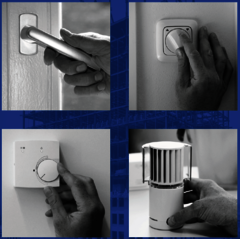
Prof Talk | Nice and warm through the winter
TU/e researcher Marcel Loomans unravels the secrets of our thermal comfort
What determines whether we find indoor temperatures comfortable? The answer turns out to be more complex than just setting the thermostat. Marcel Loomans, associate professor at the TU/e Department of the Built Environment, researches indoor environmental quality performance and explains how thermal comfort is influenced by factors such as temperature differences, age, and our own adaptability.
We all have that one colleague who always wears a thick sweater and another one who can’t get enough of air conditioning. Or a roommate who invariably turns down the thermostat while you long for a little more warmth. Thermal comfort is a subjective perception that depends heavily on several factors – from clothing, personal preferences, and activity level to the way a room is constructed or a building designed. What are the things that influence how comfortable we feel? And can we smartly adapt our environment to get our ideal comfort level without driving energy costs sky high? Cursor asked Marcel Loomans, indoor environmental quality performance researcher at TU/e.
“Indoor environmental quality performance – aka quality of the indoor environment – comprises four physical parameters: thermal comfort, air quality, lighting, and acoustics,” Loomans explains. “My main focus is on the first two, i.e., thermal and air quality.” Since the COVID pandemic, he has become more involved in ventilation issues, such as the effectiveness of air purifiers and ways to better ventilate rooms. But thermal comfort – or how we perceive the temperature in a room – remains an important area of research for him.
Flexibility
An important aspect of thermal comfort is how flexible we can be with the temperature in buildings. Loomans explains: “We researched variations in temperature. For example, how acceptable do people find temperature increases during the day? We also looked at zones with different temperatures and how people experience them.”
“People do have a certain degree of flexibility in terms of thermal comfort, which is interesting,” he continues. “This means that we don’t always have to have rigorous control of the temperature in a building.” This knowledge can be combined with the thermal mass of buildings that can be used to store heat and cold. With the varying supply of renewable energy from wind and the sun, the use of the climate system in a building can be adjusted accordingly. When supply is high, you heat the building a little more, or cool it a little more. When supply is low, you dial back the climate system. “In this way, you can also include buildings in limiting peak demand, for example. A single building’s contribution to the energy transition may be small, but the thermal mass is already there and we have a lot of buildings,” says Loomans.
From climate chambers to practice
To study thermal comfort, use is often made of ‘climate chambers’. “Subjects are placed in these rooms under controlled conditions, performing a certain activity and wearing certain clothes,” Loomans explains. “We control the air temperature, humidity, radiant temperature (heat radiated by a surface, ed.), and possibly air velocity, and ask subjects about their thermal sensation and comfort.” Such studies have also been conducted to find out, for example, when we experience drafts, or what differences between surface temperatures are still acceptable.
The results of many such experiments around the 1970s were then translated by Fanger, a Danish researcher, into a model predicting thermal comfort. In practice, however, this model didn’t always turn out to be correct. “In summer, when people can open a window and feel a breeze, things work differently,” Loomans says. “Based on field studies, an adaptive model was developed that takes better account of our ability to adapt. This model turns out to work better for buildings that have no active cooling in the summer and that do give its occupants the option of making active adjustments, so not the hermetically closed-off, fully air-conditioned office buildings.”
This adaptability is a combination of psychological and behavioral responses. “At some point, we accept that it gets a little warmer or colder. We adjust our clothing or activity, for example, but our body also has a certain degree of adaptability. This is known as physiological adaptation.”
Thermal laziness
By adjusting our clothing and getting our bodies used to lower temperatures, we can maintain our thermal comfort in winter without immediately turning up the thermostat, Loomans argues. “We’ve become a bit spoiled and are quick to turn up the heat just to be comfortable,” he says. But that indolent behavior can make our bodies thermally lazy in the long run. “It’s actually good to challenge your body a bit and take advantage of its natural adaptability,” he stresses.
He points out that he himself is not an expert in this field, but is happy to refer to the work of fellow researchers, including Wouter van Marken Lichtenbelt, professor of Ecological Energetics and Health at Maastricht University. Together with his research group, Van Marken Lichtenbelt has been researching the influence of ambient temperature on our metabolism for years. Their findings show that setting the thermostat slightly lower is not only good for the environment and your wallet, but also for your health. For example, variation in ambient temperature can be beneficial to our heart and blood vessels.
Age and health
Another major focus of research on thermal comfort is the influence of age and health. “Most studies have been done with students,” says Loomans. “But previous research at TU/e and recent research by a PhD candidate in China on elderly people shows that they experience thermal comfort differently. And vulnerable elderly people, for example people with underlying health problems, have different needs yet again.”
This shows that there are great individual differences between people, not only based on age and health, but also on gender, personal preferences, culture, and our body’s habituation to certain temperatures. “It’s possible to make things acceptable for everyone in a room with several people, as long as there are options to make personal adjustments, for example to your clothing or activity. Personal air-conditioning solutions, similar to those in the car, have also been receiving more and more attention in this regard,” he says. “However, it starts with the awareness that we are different and that inclusive design is important.”
Practical tips for a warm winter
Besides exercising our bodies and adjusting our clothing, what else can we do to stay nice and warm in winter? “If your home isn’t well insulated, start there,” Loomans advises. “It’s an investment, but insulation doesn’t only provide you with more comfort because you get higher surface temperatures inside, it also saves energy and money.”
In addition, he recommends heating smartly and locally. “Instead of heating the whole house, focus on the rooms where you actually are or where you really want it to be warm,” he says. “The bedroom, for example, often doesn’t need to be that warm at all.” While this may seem obvious, Loomans says it cannot be emphasized enough.
When people are cold, they tend to immediately turn the thermostat all the way up, but there’s no point
Furthermore, it is normally a good idea to turn down the heating at night or when you’re away during the day. But be careful about turning up the thermostat too much later on. “When people are cold, they tend to immediately turn the thermostat way up, but there’s no point. It won’t get the temperature to where you want it to be any faster, and you’ll end up with a higher temperature than you need,” he explains.
Temperature preferences vary greatly for every person and situation anyway, Loomans emphasizes. “There are rules for what we consider generally acceptable in schools or offices, but at home it very much depends on personal preference. There’s no ideal temperature.” It’s therefore important to heat consciously and adjust to personal preferences.
Don’t blindly rely on what the thermostat indicates, he warns. “The number is only indicative; depending on the exact positioning of the thermostat, it can easily be off by a few degrees,” Loomans explains. Therefore, his advice is to focus on what you yourself find comfortable.
Ventilation
What is the role of ventilation in achieving and maintaining an ideal indoor temperature? “Ventilation should preferably be considered separately from heating; it mainly has to do with air quality,” Loomans says. Older homes typically have either natural ventilation or mechanical ventilation, where fresh air enters through vents and polluted air is removed mechanically. Especially in winter, people are sometimes reluctant to ventilate, fearing heat loss and the cold air flow that can occur. In newer homes, balanced ventilation with heat recovery through a heat exchanger offers a solution to this. This system continuously ventilates and simultaneously swaps out heat between indoor and outdoor air. This guarantees fresh air without unnecessary heat loss, providing benefits such as energy savings and improved thermal comfort because less cold air is blown into a room.
Especially in older, poorly insulated homes, finding the right balance between heating, ventilating, and lowering the thermostat can be a challenge. When the temperature gets too low and there’s insufficient ventilation, condensation can accumulate, which can eventually lead to mold. “This affects not only the home, but also the air quality,” Loomans stresses. Opening windows or vents for the purpose of ventilation may seem contrary to thermal comfort, but he recommends doing so regularly to maintain healthy air quality.
Precarious balance
The use of wood stoves and fireplaces is another example of the precarious balance between air quality and thermal comfort. In his classes, Loomans illustrates this with the story of Ötzi, a Copper Age hunter found in a melted glacier in the Alps in the 1990s. “His body was exceptionally well preserved – thanks to the glacier – and extensively examined,” Loomans says. “In the process, researchers discovered that his lungs looked like he was an avid smoker.” The explanation? Ötzi often hid in caves and made fires there, so he was exposed to smoke for long periods of time, which affected his lungs. “He improved his thermal comfort, but at the expense of air quality and his health,” he says.
Wood stoves and fireplaces provide heat, but you pay the price in the form of poorer indoor air quality. The question is whether that’s worth it
The same goes for wood stoves and fireplaces, says Loomans: “They bring you heat, but you pay the price in the form of poorer indoor air quality. The question is whether that’s worth it. I’m not in favor of it myself, especially given that the outdoor environment also ends up being exposed to extra particulate matter in the air that can then re-enter homes.” Despite advances in homes and heating systems, the dilemma remains: how do we achieve thermal comfort without compromising our health or sustainability?
Comfortable and sustainable
The research by Loomans and his colleagues shows how complex thermal comfort is. It’s not only about technology, but also about behavior, health, and even cultural differences. By cleverly using thermal mass and adaptive models, we can design buildings that are not only comfortable, but also energy efficient and future-proof. “This is one of many examples where thermal comfort plays a role,” says Loomans. “Or just consider a lecture hall or a bedroom where it’s too hot; how do you think this will affect your learning performance or sleep?”
“Thermal comfort is a combination of several factors,” he concludes. “With the right approach, not only can we improve our own comfort, but also contribute to more sustainable energy consumption.”



Discussion